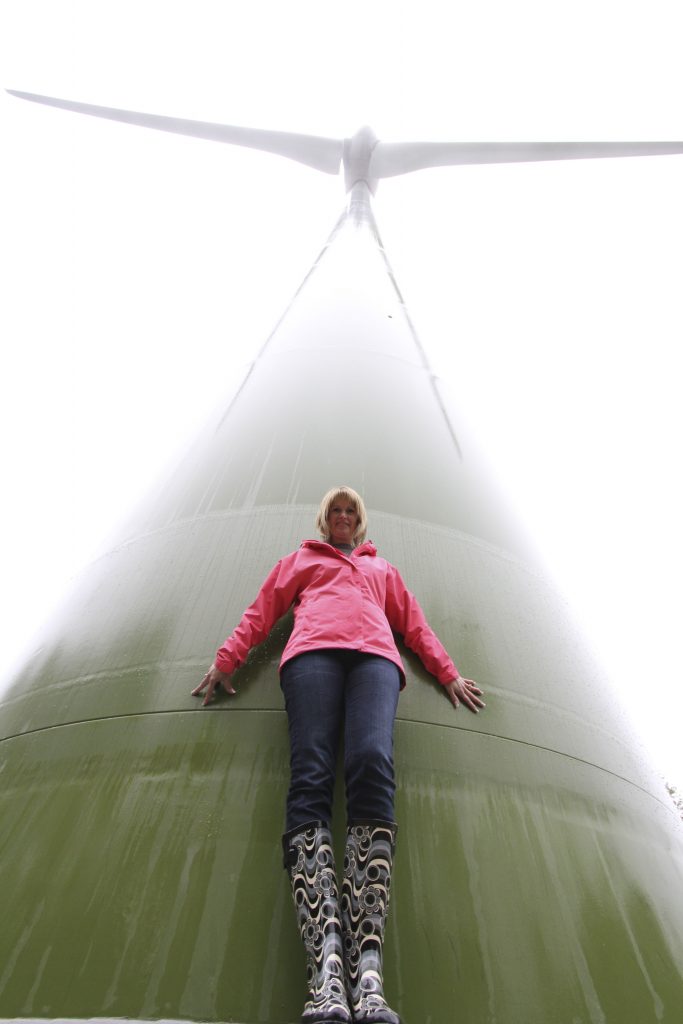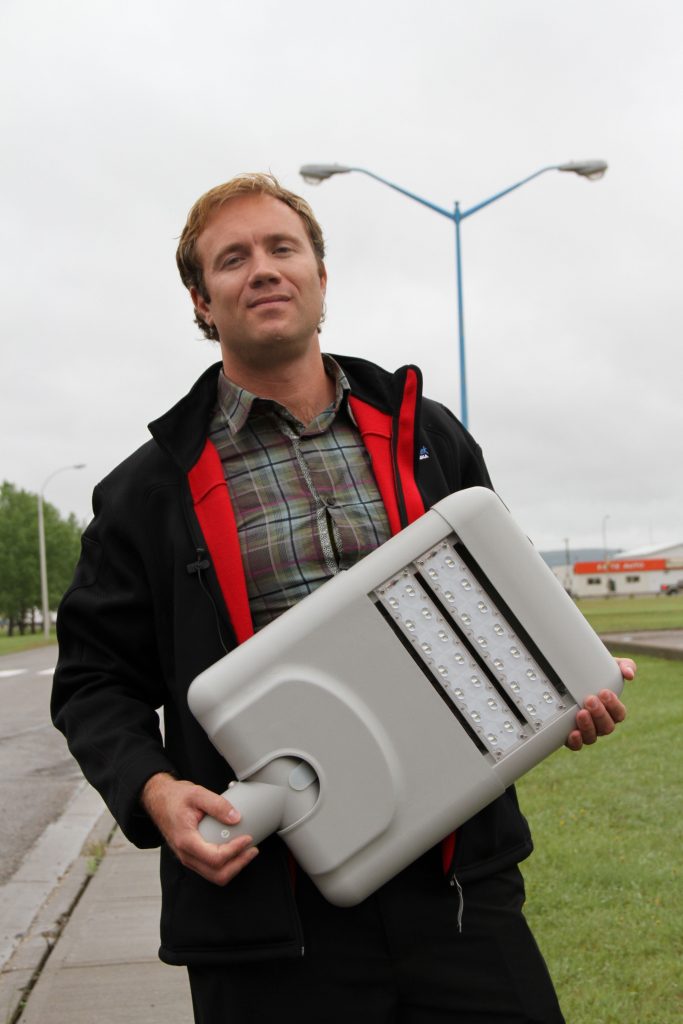By David Dodge and Duncan Kinney
Dawson Creek is in the heart of oil and gas country in the Northern Rockies and is famously located at Mile 0 of the Alaska Highway. Yet, everywhere you look are signs of green energy. From solar powered speed signs to solar thermal hot water systems on the majority of its public buildings you quickly get a sense that this city is already looking beyond fossil fuels.
The pièce de résistance is the Bear Mountain wind park – 34 wind turbines occupy the western skyline of Dawson Creek like green energy sentinels. The 102-megawatt wind farm consists of 34 German-made Enercon wind turbines that produce much more energy than the 12,000 residents of Dawson Creek need.

This image of Dawson Creek at night with the Bear Mountain Wind Park in the background was taken by photographer Don Pettit.

Cheryl Shuman, a city councillor for Dawson Creek, describes herself as a turbine hugger. She’s also a member of the Peace Energy Cooperative, the group that helped bring the Bear Mountain Wind Park to a ridge overlooking Dawson Creek.
Standing in front of one of the giant 78 metre turbines City Councillor Cheryl Shuman smiles wryly when I call it a wind “farm.”
It’s a park not a wind farm she corrects me and rapidly lists off what people use the space for; hiking, climing, picnics, cross-country skiing, ATVing and even birdwatching.
Bear Mountain was the first large wind project in B.C. and it was developed by a local group of people with considerable public support from residents. In Dawson Creek this commitment to green energy is also evident among politicians, city staff and in the city’s award winning efforts to produce renewable energy, increase energy efficiency and reduce carbon emissions.
Click here for a Flickr slideshow of the Bear Mountain Wind Park
A Happy Accident
Dawson Creek started as an accidental settlement by folks on the road to the Klondike. Settlers slowly drifted in over the years to homestead and take up farming, but people started arriving in numbers with arrival of the Northern Alberta Railway in 1931.
The City’s head of infrastructure and sustainable development Kevin Henderson says it’s these agricultural roots that have ingrained the concept of sustainability into the people of the region.
In recent years a massive shale gas industry was added to the mix. “We are right in the middle of one of the biggest gas booms in BC’s history right here in Dawson Creek, but on top of that the City is winning all sorts of sustainability and green awards,” says Mayor Mike Bernier.
The former Mayor, Calvin Kruk was an artist and a big advocate of green energy. He was active with the Peace Energy Cooper started by local photographer Don Petitt. It was their dream of profiting from local, renewable energy that led to BC’s first big wind farm being built in Dawson Creek.
Today the city is building the Calvin Kruk Centre for the Arts
as a tribute to Kruk who died from cancer in 2008. The city is renovating the heritage federal post office building with state of the art green technology as part of Dawson Creek’s commitment to become “carbon neutral by 2012.”
Municipal Carbon Tax

One of Mayor Mike Bernier’s favourite bragging points is the Bear Mountain Wind Park, BC’s first large scale wind development. Photo David Dodge, GreenEnergyFutures.ca
The City of Dawson Creek has imposed a $100/tonne levy on its own greenhouse gas emissions. The money goes into the Dawson Creek Carbon Fund and it’s used to fund energy efficiency and renewable energy projects.
“Last year when we did our audits we emitted 3,600 tonnes, so we made sure we put aside $360,000 into a separate fund and that fund can only be used for green initiatives within the community,” says Mayor Bernier.
This city is pretty serious about going green. They have completed energy audits of public buildings, carried electrical retrofits and they’ve installed a solar photovoltaic system right on City Hall.
The thing you notice when you come to town is many of the green energy initiatives are quite

Matthew MacWilliam is the new energy manager for the city of Dawson Creek. His salary is paid for by BC Hydro and it’s his job to ensure the city uses less energy. His first project? Replacing high-pressure sodium streetlights with LEDs which are 66 per cent more efficient. Photo David Dodge, GreenEnergyFutures.ca
visible, which seems to play on and support the sense of civic pride associated with Dawson’s journey to sustainability.
The city has cut its use of natural gas by installing solar thermal hot water systems on city hall, the fire hall, the police hall and at the airport.
This thinking also extends to vehicle purchasing where the city is “right-sizing” its fleet, purchasing hybrids and the city even has its first plug-in hydrid Toyota Prius. initiatives.
Dawson Creek even has it’s own energy manager, a staff position of the city funded by BC Hydro.
Matthew MacWilliam’s very first project will be to bring in LED streetlights to replace the high-pressure sodium streetlights the city currently has. These LEDs will use 66 per cent less energy. You multiply that over the 500 lights the city is responsible for and you start to see some real savings.
Click here for a slideshow of Dawson Creek’s many renewable energy and energy efficiency projects
The Snowball Effect
First, a few residents set out to create the very first wind farm in BC and wind up working with private companies to build a 102 megawatt wind park overlooking town. Then these residents join with other residents, city staff and some become politicans and before you know it Dawson Creek has serious sustainability program up and running.
“My belief is that it all started with the Peace Energy Cooperative,” says councillor Cheryl Shuman. From there it spread to City Hall and the city staff and from there the whole idea of sustainable Dawson Creek and Planning for People emerged and spread over the community, says Shuman. “I think when you have a good idea and you start acting on it other people will get excited and get involved.”So when the folks at Northern Lights College proposed creating a small $300,000 demonstration energy centre, senior executives at the college figured why not do it up right.
They raised $7 million and today the Northern Lights College Energy Centre has a biomass heating system that provides 70 per cent of the heat for the entire campus, a geothermal heating system, solar thermal systems, a solar photovoltaic system, a rainwater collection system and a state-of-the art Center for Excellence for Clean Energy Technology.
Click here for a Flickr slideshow of the Energy House

Northern Lights College raised $7 million in order to build the Energy House, a demonstration learning building where students can learn about multiple renewable energy technologies. Photo David Dodge, GreenEnergyFutures.ca
“The Energy House was designed to teach clean energy technologies. Dawson Creek had the province’s first wind farm so we felt it was appropriate to create the first wind energy technician program in BC,” says Bob Haugen, program coordinator.
“We’re teaching students how to install solar thermal systems, solar photovoltaic systems, geoexchange systems, and rainwater collection systems. We have ten courses within that diploma program that will lead students to become clean energy technologists, ” says Haugen. The program starts in October. (see our video tour of the Energy Centre)
The week we spoke with Bob Haugen, the long-time resident announced he was leaving Dawson Creek to become the executive director of the Canadian Solar Cities Project in Victoria. Perhaps not surprisingly, Dawson Creek is slated to become Canada’s first official “solar city.”
While the olive groves are still in development Dawson Creek gets as much sunshine as the Mediterranean. And in an odd twist of fate solar panels actually become more efficient the colder it gets. Taking advantage of their immense solar bounty only makes sense for Dawson Creek.
You could forgive Councillor Cheryl Shuman when she calls her home city “awesome Dawson,” but if you stay in town long enough, you just might start to agree with her. This little northern City is going carbon neutral, right in the heart of oil and gas country.
-30-

A turbine rises from the mist on a cloudy day as trees frame it at the Bear Mountain Wind Park which overlooks Dawson Creek.

